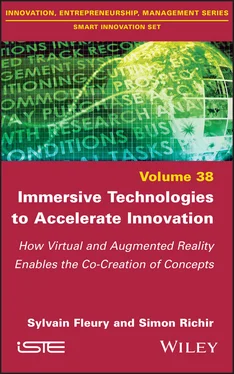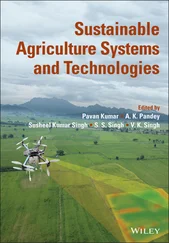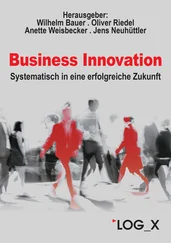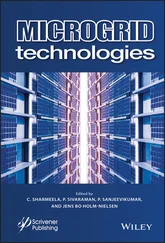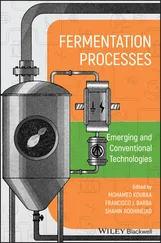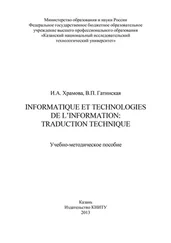4 Chapter 4Figure 4.1. The five steps of Design Thinking by Stanford University. For a color version of this figure, see www.iste.co.uk/fleury/innovation.zipFigure 4.2. The UK Design Council’s Double Diamond modelFigure 4.3. Representation of the “Feedback Loop” or “Lean Startup Cycle”. For a color version of this figure, see www.iste.co.uk/fleury/innovation.zipFigure 4.4. The five steps of the Time to Concept approach represented “Design Thinking style”. For a color version of this figure, see www.iste.co.uk/fleury/innovation.zipFigure 4.5. When a Post-it session is conducted right after a collaborative game, participants let go more easily during the divergence, communicate more and are more inventive. For a color version of this figure, see www.iste.co.uk/fleury/innovation.zipFigure 4.6. Examples of inspirations used by our team: a shelf of immersive technologies (left) and a prospective virtual environment that can be configured by the facilitator and allows participants to immerse themselves in a residential neighborhood of the future (right). For a color version of this figure, see www.iste.co.uk/fleury/innovation.zip
5 Chapter 5Figure 5.1. Overall schematic representation of the problem-solving approach with TRIZ. For a color version of this figure, see www.iste.co.uk/fleury/innovation.zipFigure 5.2. Schematic representation of Design Sprint (from GV.com). For a color version of this figure, see www.iste.co.uk/fleury/innovation.zip
6 Chapter 7Figure 7.1. Screenshots of Time2Craft (top and bottom left): simple shapes can be made in a very clean interface, directly in CAD software (bottom right). For a color version of this figure, see www.iste.co.uk/fleury/innovation. zipFigure 7.2. On the left, the drum-like keyboard, and on the right, the individual text-to-speech microphone, and the collective text-to-speech recording. For a color version of this figure, see www.iste.co.uk/fleury/innovation.zipFigure 7.3. Example of a collaborative work situation with one user immersed in a headset while the second user views the environment on a large screen, commenting on the actions of his or her colleague. For a color version of this figure, see www.iste.co.uk/fleury/innovation.zipFigure 7.4. The “Affordance and Constraint Network” (according to Fromm et al. 2020)Figure 7.5. Augmented reality visualization of a 3D mechanical part with an animation showing the direction of flow in the part. For a color version of this figure, see www.iste.co.uk/fleury/innovation.zipFigure 7.6. Virtual reality meeting situation in our team with presentation of results graphs: instead of displaying a slide show on a screen, the graphs are spread out on the walls of the virtual room. Thus, during the presentation, the facilitator and his colleagues move around the environment, viewing each graph as they would move from painting to painting in a museum. For a color version of this figure, see www.iste.co.uk/fleury/innovation.zipFigure 7.7. Cokoon application developed by our team, allowing to cut freehand in a scanned point cloud in order to quickly test in virtual reality rearrangements of existing environments. For a color version of this figure, see www.iste.co.uk/fleury/innovation.zipFigure 7.8. Application “La plume et la lanterne” (the feather and the lantern) designed by students of Arts et Métiers as an immersive experience that is both playful and contemplative, conducive to letting go. For a color version of this figure, see www.iste.co.uk/fleury/innovation.zipFigure 7.9. The seven categories of determinants of creativity tool choiceFigure 7.10. Schematic representation of the uses of virtual reality in a Design Thinking project. For a color version of this figure, see www.iste.co.uk/fleury/innovation.zipFigure 7.11. Schematic representation of the uses of virtual reality in a Lean Startup project. For a color version of this figure, see www.iste.co.uk/fleury/innovation.zipFigure 7.12. Schematic representation of the uses of virtual reality in a project conducted with the Time to Concept approach. For a color version of this figure, see www.iste.co.uk/fleury/innovation.zipFigure 7.13. Representation of the stages in which virtual reality applications intervene in a creativity workshop (according to Graessler and Taplick 2019). For a color version of this figure, see www.iste.co.uk/fleury/innovation.zip
7 Chapter 8Figure 8.1. Example of an exercise used in our team to learn about Time2Sketch, our immersive drawing tool. The participants have to imagine and draw a logo for their team. For a color version of this figure, see www.iste. co.uk/fleury/innovation.zipFigure 8.2. Example of a collaborative work situation at the Institut Arts et Métiers de Laval, with a user creating three-dimensional animations in virtual reality, assisted by his or her colleague visualizing the result in the room in augmented reality. For a color version of this figure, see www.iste.co.uk/fleury/innovation.zip
1 Cover
2 Table of Contents
3 Title Page Smart Innovation Set coordinated by Dimitri Uzunidis Volume 38
4 Copyright First published 2021 in Great Britain and the United States by ISTE Ltd and John Wiley & Sons, Inc. Apart from any fair dealing for the purposes of research or private study, or criticism or review, as permitted under the Copyright, Designs and Patents Act 1988, this publication may only be reproduced, stored or transmitted, in any form or by any means, with the prior permission in writing of the publishers, or in the case of reprographic reproduction in accordance with the terms and licenses issued by the CLA. Enquiries concerning reproduction outside these terms should be sent to the publishers at the undermentioned address: ISTE Ltd 27-37 St George’s Road London SW19 4EU UK www.iste.co.uk John Wiley & Sons, Inc. 111 River Street Hoboken, NJ 07030 USA www.wiley.com © ISTE Ltd 2021 The rights of Sylvain Fleury and Simon Richir to be identified as the authors of this work have been asserted by them in accordance with the Copyright, Designs and Patents Act 1988. Library of Congress Control Number: 2021943895 British Library Cataloguing-in-Publication Data A CIP record for this book is available from the British Library ISBN 978-1-78630-770-5
5 Begin Reading
6 Conclusion
7 References
8 Index
9 End User License Agreement
1 iii
2 iv
3 ix
4 x
5 xi
6 xii
7 xiii
8 xiv
9 xv
10 xvi
11 1
12 2
13 3
14 4
15 5
16 6
17 7
18 8
19 9
20 10
21 11
22 12
23 13
24 14
25 15
26 16
27 17
28 18
29 19
30 20
31 21
32 22
33 23
34 24
35 25
36 26
37 27
38 28
39 29
40 30
41 31
42 32
43 33
44 34
45 35
46 36
47 37
48 38
49 39
50 40
51 41
52 43
53 44
54 45
55 46
56 47
57 48
58 49
59 50
60 51
61 52
62 53
63 54
64 55
65 56
66 57
67 58
68 59
69 60
70 61
71 62
72 63
73 64
74 65
75 67
76 68
77 69
78 70
79 71
80 72
81 73
82 74
83 75
84 76
85 77
86 78
87 79
88 80
89 81
90 83
91 84
92 85
93 86
94 87
95 88
96 89
97 90
98 91
99 92
100 93
101 94
102 95
103 96
104 97
105 98
106 99
107 100
108 101
109 102
110 103
111 104
112 105
113 106
114 107
115 108
116 109
117 110
118 111
119 112
120 113
Читать дальше
